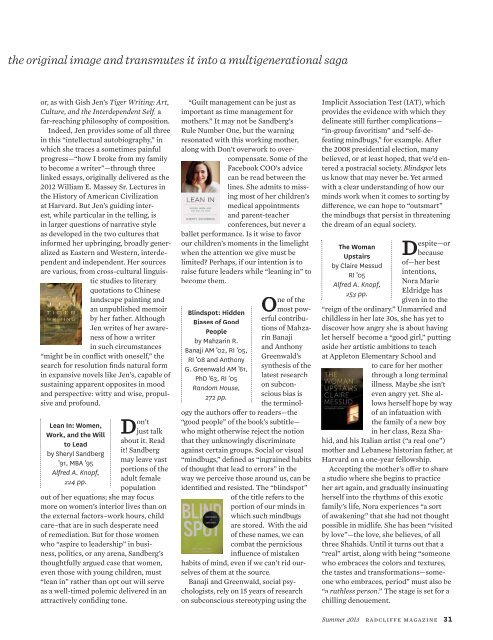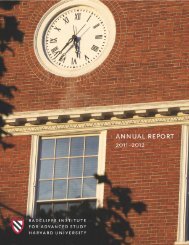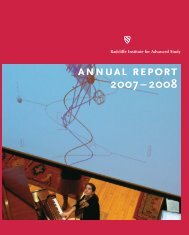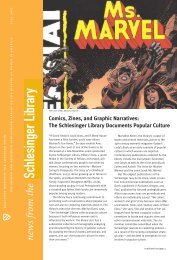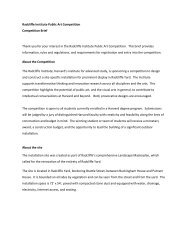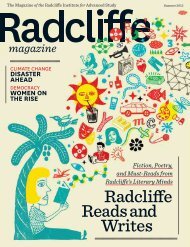Download - Radcliffe Institute for Advanced Study - Harvard University
Download - Radcliffe Institute for Advanced Study - Harvard University
Download - Radcliffe Institute for Advanced Study - Harvard University
You also want an ePaper? Increase the reach of your titles
YUMPU automatically turns print PDFs into web optimized ePapers that Google loves.
the original image and transmutes it into a multigenerational saga<br />
or, as with Gish Jen’s Tiger Writing: Art,<br />
Culture, and the Interdependent Self a<br />
far-reaching philosophy of composition.<br />
Indeed, Jen provides some of all three<br />
in this “intellectual autobiography,” in<br />
which she traces a sometimes painful<br />
progress—“how I broke from my family<br />
to become a writer”—through three<br />
linked essays, originally delivered as the<br />
2012 William E. Massey Sr. Lectures in<br />
the History of American Civilization<br />
at <strong>Harvard</strong>. But Jen’s guiding interest,<br />
while particular in the telling, is<br />
in larger questions of narrative style<br />
as developed in the two cultures that<br />
in<strong>for</strong>med her upbringing, broadly generalized<br />
as Eastern and Western, interdependent<br />
and independent. Her sources<br />
are various, from cross-cultural linguistic<br />
studies to literary<br />
quotations to Chinese<br />
landscape painting and<br />
an unpublished memoir<br />
by her father. Although<br />
Jen writes of her awareness<br />
of how a writer<br />
in such circumstances<br />
“might be in conflict with oneself,” the<br />
search <strong>for</strong> resolution finds natural <strong>for</strong>m<br />
in expansive novels like Jen’s, capable of<br />
sustaining apparent opposites in mood<br />
and perspective: witty and wise, propulsive<br />
and profound.<br />
Lean In: Women,<br />
Work, and the Will<br />
to Lead<br />
by Sheryl Sandberg<br />
’91, MBA ’95<br />
Alfred A. Knopf,<br />
224 pp.<br />
Don’t<br />
just talk<br />
about it. Read<br />
it! Sandberg<br />
may leave vast<br />
portions of the<br />
adult female<br />
population<br />
out of her equations; she may focus<br />
more on women’s interior lives than on<br />
the external factors–work hours, child<br />
care–that are in such desperate need<br />
of remediation. But <strong>for</strong> those women<br />
who “aspire to leadership” in business,<br />
politics, or any arena, Sandberg’s<br />
thoughtfully argued case that women,<br />
even those with young children, must<br />
“lean in” rather than opt out will serve<br />
as a well-timed polemic delivered in an<br />
attractively confiding tone.<br />
“Guilt management can be just as<br />
important as time management <strong>for</strong><br />
mothers.” It may not be Sandberg’s<br />
Rule Number One, but the warning<br />
resonated with this working mother,<br />
along with Don’t overwork to overcompensate.<br />
Some of the<br />
Facebook COO’s advice<br />
can be read between the<br />
lines. She admits to missing<br />
most of her children’s<br />
medical appointments<br />
and parent-teacher<br />
conferences, but never a<br />
ballet per<strong>for</strong>mance. Is it wise to favor<br />
our children’s moments in the limelight<br />
when the attention we give must be<br />
limited Perhaps, if our intention is to<br />
raise future leaders while “leaning in” to<br />
become them.<br />
Blindspot: Hidden<br />
Biases of Good<br />
People<br />
by Mahzarin R.<br />
Banaji AM ’02, RI ’05,<br />
RI ’08 and Anthony<br />
G. Greenwald AM ’61,<br />
PhD ’63, RI ’05<br />
Random House,<br />
272 pp.<br />
One of the<br />
most powerful<br />
contributions<br />
of Mahzarin<br />
Banaji<br />
and Anthony<br />
Greenwald’s<br />
synthesis of the<br />
latest research<br />
on subconscious<br />
bias is<br />
the terminology<br />
the authors offer to readers—the<br />
“good people” of the book’s subtitle—<br />
who might otherwise reject the notion<br />
that they unknowingly discriminate<br />
against certain groups. Social or visual<br />
“mindbugs,” defined as “ingrained habits<br />
of thought that lead to errors” in the<br />
way we perceive those around us, can be<br />
identified and resisted. The “blindspot”<br />
of the title refers to the<br />
portion of our minds in<br />
which such mindbugs<br />
are stored. With the aid<br />
of these names, we can<br />
combat the pernicious<br />
influence of mistaken<br />
habits of mind, even if we can’t rid ourselves<br />
of them at the source.<br />
Banaji and Greenwald, social psychologists,<br />
rely on 15 years of research<br />
on subconscious stereotyping using the<br />
Implicit Association Test (IAT), which<br />
provides the evidence with which they<br />
delineate still further complications—<br />
“in-group favoritism” and “self-defeating<br />
mindbugs,” <strong>for</strong> example. After<br />
the 2008 presidential election, many<br />
believed, or at least hoped, that we’d entered<br />
a postracial society. Blindspot lets<br />
us know that may never be. Yet armed<br />
with a clear understanding of how our<br />
minds work when it comes to sorting by<br />
difference, we can hope to “outsmart”<br />
the mindbugs that persist in threatening<br />
the dream of an equal society.<br />
The Woman<br />
Upstairs<br />
by Claire Messud<br />
RI ’05<br />
Alfred A. Knopf,<br />
253 pp.<br />
Despite—or<br />
because<br />
of—her best<br />
intentions,<br />
Nora Marie<br />
Eldridge has<br />
given in to the<br />
“reign of the ordinary.” Unmarried and<br />
childless in her late 30s, she has yet to<br />
discover how angry she is about having<br />
let herself become a “good girl,” putting<br />
aside her artistic ambitions to teach<br />
at Appleton Elementary School and<br />
to care <strong>for</strong> her mother<br />
through a long terminal<br />
illness. Maybe she isn’t<br />
even angry yet. She allows<br />
herself hope by way<br />
of an infatuation with<br />
the family of a new boy<br />
in her class, Reza Shahid,<br />
and his Italian artist (“a real one”)<br />
mother and Lebanese historian father, at<br />
<strong>Harvard</strong> on a one-year fellowship.<br />
Accepting the mother’s offer to share<br />
a studio where she begins to practice<br />
her art again, and gradually insinuating<br />
herself into the rhythms of this exotic<br />
family’s life, Nora experiences “a sort<br />
of awakening” that she had not thought<br />
possible in midlife. She has been “visited<br />
by love”—the love, she believes, of all<br />
three Shahids. Until it turns out that a<br />
“real” artist, along with being “someone<br />
who embraces the colors and textures,<br />
the tastes and trans<strong>for</strong>mations—someone<br />
who embraces, period” must also be<br />
“a ruthless person.” The stage is set <strong>for</strong> a<br />
chilling denouement.<br />
Summer 2013 radcliffe magazine 31


